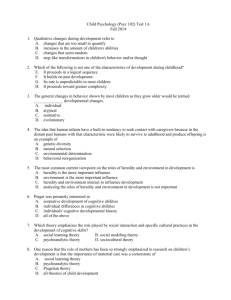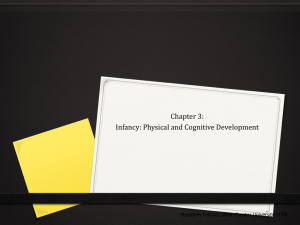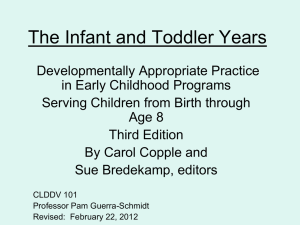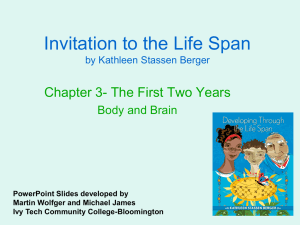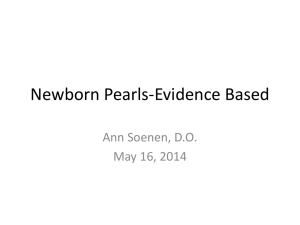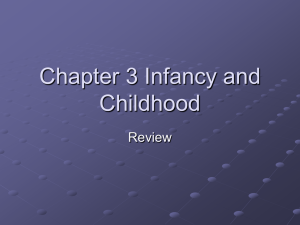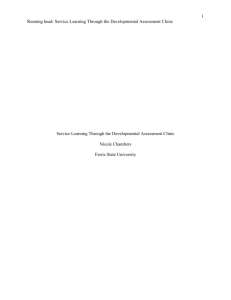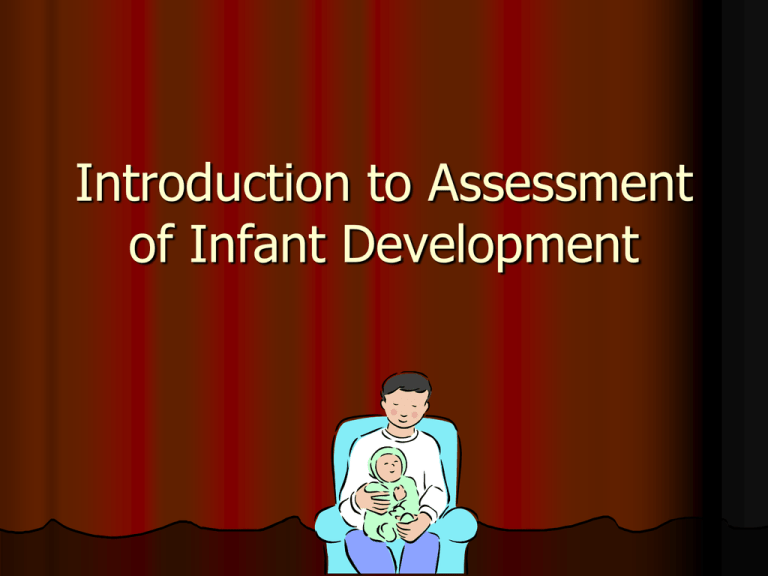
Introduction to Assessment
of Infant Development
Principles and Techniques of
Observing Young Children
To monitor children’s development and
learning
To guide our planning and decision
making
To identify children who might benefit
from special services
To report to and communicate
with others
Tests and Test Development
Norm-Referenced Assessment
Criterion-Referenced Assessment
Norm-Referenced Assessment
Compares a child’s development to a
group of other children who are similar in
age, sex, geographic location, income
level, race, disability and/or cultural
background
Limitations of Norm-Referenced
Assessment
Normative samples
Poorer reliability and validity
a. Based on monolingual, typically developing children
b. Do not generally provide information on the normative
development of bilingual or atypically developing children
a. Lower sample sizes
b. Inappropriate assumption of linear growth during the
preschool years
Preschool children have limited experience
taking tests
a. Difficulty controlling behavior during testing
situations
b. May not transition from one task to another in
rapid sequence
Limitations Cont.
Cultural biases
a. Content reflects formal language used in dominant,
mainstream culture
b. Standardized tests do not take into account contextual
influences on the measurement of children’s behavior
c. Do not take into account cultural differences in values, beliefs
and attitudes
Do not measure children’s abilities in across contexts
a. Generally administered in one session
b. Generally conduted in unfamiliar situations
c. Young children’s performance on tests is directly affected by
the context (e.g., familiarity of test administrator, familiarity of
task, materials used, social and physical environment)
Limitations Cont.
Do not draw from observations and interactions of
children and families engaged in actual tasks
a. Isolated skills
b. Items chosen based on capacity to discriminate between groups
of children of different ages
c. Items not necessarily educationally relevant
Do not measure children’s learning potential by providing
information on what child can do with mediation by an
adult
a. Standardized procedures
b. Adaptations and modifications not allowed
c. No information on what child can do with and without mediation
by an adult
Criterion-Referenced Assessment
Compares a child's abilities to a specified level of
accuracy or "criteria"
For example:
a skill such as cutting can have the following criteria: the child
cuts independently, the child cuts within a quarter of an inch of
a line, the child cuts a variety of shapes on paper
a skill such as rolling a ball can have the following criteria: the
child rolls the ball or a similar object with one or two hands, the
child rolls the ball within eighteen inches of a target
Unlike norm-referenced assessments,
criterion-referenced assessments gives
us information we can use to plan programs
for children.
Alternative Assessment
Embedded Approaches
Authentic Approaches
Mediated Approaches
Embedded Approaches
Naturalistic Assessment
Methods in which multiple opportunities for children to perform
skills across domains of development are embedded in the context
of child-initiated, routine, and planned activities
Caregivers, and others who interact with the child on a regular
basis, are responsible for observing the child and recording
assessment information
Addresses functional skills that will enhance the child’s
independence and social interactions across settings
Focused Assessment
Observations using adult-structured interactions to elicit specific
behaviors for assessment purposes usually occur within the context
of familiar activities and situations
Assessor concentrates multiple behaviors across different areas into
a single situation and uses specific strategies to elicit targeted skills
Advantages and Disadvantages of
Embedded Approaches
Advantages
Measures language as used in daily routines,
activities, and meaningful contexts
Use of familiar tasks and culturally-appropriate
materials
Disadvantages
Observational assessment of children’s behavior is not
always time efficient
Relevant behaviors may not be readily observable in
classroom-based programs (e.g., dressing and
undressing)
Authentic Approaches
Portfolio Assessment
A purposeful collection of a child’s work that can be used to document
the child’s efforts, progress, and achievements over time
Open-ended and flexible
The content depends on educational goals and purposes and can
include a variety of children’s work as well as teacher and parent
observations
The child participates in the selection and evaluation of the content
Performance Assessment
Broad term that refers to methods in which children are given
the opportunity to demonstrate their knowledge and
apply it (e.g., being able to tell a story, build a model of
a playground area, climb a ladder, draw a picture of a pet,
create a shopping list)
Tasks can be developed specifically for the assessment
or can occur as part of daily routines
Authentic Assessment: When tasks are completed in a
real-life context (e.g., writing a letter to a friend,
swimming at the local pool)
Advantages and Disadvantages of
Authentic Assessment
Advantages
Performance assessment allows children to demonstrate
language skills in meaningful real-life situations and gives a
more authentic view of the child's skills
Portfolio documentation of various forms of language use
provides concrete and meaningful picture of children's progress
Disadvantages
Clear and objective criteria for judging performance can be
difficult
Limited empirical data available on technical qualities, student
outcomes, and feasibility
Mediated Approaches
Dynamic Assessment
A broad term used for various distinct approaches that are
characterized by guided support or learning for the purpose of
determining a child’s potential for learning and responsivity to
instruction by comparing what the child does independently and
what the child is able to do with additional support and
assistance
Corresponds to the child’s zone of proximal development
Curriculum-Based Language Assessment
The identification and analysis of potential gaps between the
linguistic demands of a particular context and the linguistic
competence of a learner
Language use in the context of the school curriculum is the most
significant factor in determining whether children succeed
Differences exist between languages spoken in homes versus
language required to function in school.
Advantages and Disadvantages of
Mediated Approaches
Advantages
Measures potential for learning ability and children's responsivity to
adult mediation
Allows for modifications such as rewording instructions, providing
additional time, or repeated presentation of a task
Allows asking children to provide an explanation for their responses
Disadvantages (of Dynamic Approaches)
Have not been sufficiently field tested
Have primarily been developed for research purposes are not
necessarily suited for use in real-life settings
Collecting information in real-life settings requires additional training
for practitioners
Developmental Assessment
Tools and Procedures for Infants
1.
Bayley Infant Neurodevelopmental Screener
2.
Ages and Stages Questionnaires
3.
Bayley Scales of Infant Development
4.
Assessment, Evaluation & Programming
System - Birth to 3
5.
Carolina Curriculum for Infants and Toddlers
Bayley Infant
Neurodevelopmental Screener
Description: This screening tool is designed to identify infants who are
developmentally delayed or hove This screening tool is designed to identify infants
who are developmentally delayed or hove neurological impairments. The tool
includes four areas including basic neurological functions/intactness; receptive
functions; expressive functions; and cognitive processes.
Tips for Administration:
Will generally take 10 minutes to administer when experienced, but will take
longer if administering for the first time or depending on the behavioral and
emotional state of the infant..
Recommended that examiners be thoroughly familiar with infant development
and are experienced in handling infants.
Materials included in the kit with the exception of a few.
Clear directions including the infant’s position, materials needed, administration
and scoring procedures provided for each item.
Tips for Interpretation:
Although designed as a screening instrument, has been used to track
development of infants who have been diagnosed with a disability.
Psychometric Properties:
Strong reliability and validity data have been reported.
Ages and Stages Questionnaires
(from birth to 5 years)
Description: This tool is designed to identify children who may have developmental
delays. The screening tool contains 19 questionnaires that are easily completed by
parents or caregivers to monitor development at the following intervals: 4, 6 8, 10,
12, 14, 16, 18, 20, 22, 24, 27, 30, 33, 36, 42, 48, 54, and 60 months of age. Areas
of development assessed include: Communication, Gross Motor, Fine Motor, Problem
Solving, and Personal-Social.
Tips for Administration:
Will generally take 10 to 20 minutes to complete.
Score items by marking: Yes, Sometimes, or Not Yet
Can be administered through interview format
Scoring should take less than 5 minutes
By comparing results to shaded graphs, you can easily detect concerns in any
area
Tips for Interpretation:
Consistent method for monitoring developmental progress without formal visit
It is a culturally sensitive way to identify children who are in need of further
assessment or who need to be monitored over time.
Psychometric Properties:
Strong reliability and validity data have been reported.
Bayley Scales of Infant
Development - 2nd Edition
Description: This tool is designed to assess the developmental functioning of
infants. The tool includes three subscales: the Mental Scale, the Motor Scale, and the
Behavior Rating Scale.
Tips for Administration:
Psychologists administer this test.
If experienced, will generally take 25-30 minutes to administer if infant is under
15 months, will take up to 60 minutes to administer if infant is over 15 months.
Recommended that examiners be thoroughly familiar with infant development
and are experienced in handling infants.
Materials are included in the kit.
Clear directions including the infant’s position, materials needed, administration
and scoring procedures provided for each item.
Tips for Interpretation:
The instrument has been used to report the developmental functioning of
infants. It is considered a well standardized test by early intervention clinicians.
Psychometric Properties:
Strong reliability and validity data have been reported. In addition, normative
data are provided for children who were born prematurely, have the HIV
antibody, were prenatally drug exposed, were asphyxiated at birth, are
developmentally delayed or have frequent otitis media, are autistic, or have
Down syndrome.
The Assessment, Evaluation and
Programming System for Infants
and Children-2nd ed.
Description: The Assessment, Evaluation and Programming System for Infants and
Children-2nd ed. is designed to assess the developmental abilities of children in the fine
motor, gross motor, adaptive, cognitive, social-communication, and social domains of
behavior and the results may be used for intervention planning and evaluation.
Tips for Administration:
Generally takes 2 to 3 hours depending on user’s familiarity.
Administered through observation, family report, direct testing.
Allows for qualifying notes to explain performance on items.
Can be administered to individual children or groups of children.
Assessment activities provided to facilitate scoring.
Most materials found in classroom setting.
Tips for Interpretation:
Scoring allows for emerging skills.
All items are potential IFSP or IEP intervention objectives.
Has an associated curriculum
Curriculum can be used with children who are at-risk, or who have mild, moderate, or
severe developmental delays.
Psychometric Properties:
None
Carolina Curriculum for Infants
with Special Needs – Third Ed.
Description: This criterion-referenced tool is designed to determine what skills a
child has mastered in the following areas: cognition, communication, social
adaptation, fine motor, and gross motor domains.
Tips for Administration:
Generally takes 2 to 3 hours depending on user’s familiarity with tool.
Administered through observation.
Most materials found in classroom setting.
Tips for Interpretation:
Scoring allows for a plus for master or a minus for emerging.
Items can be used for intervention objectives.
Difficult to distinguish between items that are emerging and items not observed.
Psychometric Properties:
None
Getting Ready for Arena
Assessment
Video Tape Practice
Scoring
the Assessment,
Evaluation and Programming
System
Administration of Assessment,
Evaluation and Programming
System
Guest Family
Interpretation of Developmental
Assessment Results
Interpretation of findings of the
assessment after the family leaves
Development of Individualized
Family Service Plans
The law is very specific as to what the IFSP must contain. It must have:
A statement of the child’s present levels of academic achievement and functional
performance
A statement of measurable annual goals
A description of how the child’s progress toward meeting the annual goals will be
measured
A statement of the special education and related services and supplementary aids and
services, based on peer-reviewed research to the extent practicable
A statement of the extent, if any, the child will not participate with non-disabled children
in the regular class
A statement of any individual appropriate accommodations that are necessary to
measure the academic achievement and functional performance of the child on State
and district wide assessments
The projected date for beginning services and the duration of services
Beginning not later than the first IEP to be in effect when the child is 16, and updated
annually thereafter, a statement of the transition needs
Writing Family Outcome
Statements
A statement that addresses a family's priorities, resources and concerns in
relationship to their ability to enhance their child's development
Reasons for Developing:
1.
2.
3.
4.
Example: Jane (Mother) will participate in a weekend Cardio-Pulmonary Resuscitation class
offered by the American Red Cross by the end of September. Jane would like to develop the
skills necessary to help her daughter when she has difficulty swallowing or chokes on foods.
Legal mandates
Recognizing and identifying the child and/or family strengths
Help to understand the child as part of the family system
Can expand the base of information used to evaluate children's progress
Features of Family Outcome Statements
1.
2.
3.
4.
Reflects the family's priorities, concerns, and resources
Includes activities to determine how it will be accomplished
Identifies a projected time of completion
Identifies the expectations of the family at the time of completion
Writing Child Outcome
Statements
A statement that addresses goal or a reasonable expectation of
progress for a child within a twelve-month period
Reasons for Developing
An important part of building a partnership with families
2. Assures that families and professionals agree on what the child will
learn and how the team will know when the child has learned it
3. Coordinate the evaluation of intervention services
4. Guide the team in meeting the families' priorities, concerns, and
resources for child development and family functioning
1.
Questions to Ask about Child Outcomes
Have the family's concerns been given priority?
Is the goal developmentally appropriate?
3. Will the goal benefit the child in future
environments?
4. Do sensory or motor impairments affect the
child's ability to learn the skill?
1.
2.
Conducting an Individualized
Family Service Plan Meeting
The IFSP meeting provides families and professionals
the time to share their concerns about the child's
needs and discuss the child's strengths. During the
IFSP meeting, priorities and resources for the family
also may be communicated. If families and
professionals use this opportunity to share information
with honesty and openness, a relationship built on
trust may begin to develop.
Role Play Activity
Criteria for Evaluating Outcomes
for Families and Children
There should be criteria and timelines for each outcome:
Rating
1
Criteria
Situation changed--no longer a need
2
Situation unchanged--still a need, goal, or project
3
Implementation begun--still a need, goal, or project
4
Outcome partially attained/accomplished, but not to the
family’s satisfaction
Outcome attained/accomplished, but not to the family’s
satisfaction
Outcome mostly attained/accomplished to the family’s
satisfaction
Outcome completely attained/accomplished to the
family’s satisfaction
5
6
7



